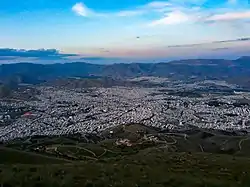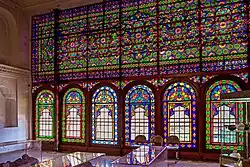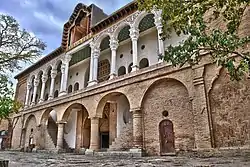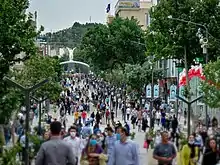Sanandaj
Sanandaj (Persian: سنندج, pronounced [sænænˈdædʒ] ⓘ; Kurdish: سنە, romanized: Sine, also romanized as Senneh[4]) is a city in the Central District of Sanandaj County, in the Kurdistan province of Iran, serving as the capital of the district, the county and the province. With a population of 414,069,[5] Sanandaj is the twenty third largest city in Iran and the second largest Kurdish city.
Sanandaj
Kurdish: سنە Sine | |
|---|---|
City | |
| Persian: سنندج | |
   .jpg.webp) Sanandaj from Abidar, Sanandaj Museum, Khosro Abad Mansion, Qeshlaq Bridge | |
 Seal | |
 Sanandaj .svg.png.webp) Sanandaj | |
| Coordinates: 35°18′41″N 46°59′46″E[1] | |
| Country | Iran |
| Province | Kurdistan |
| County | Sanandaj |
| District | Central |
| Government | |
| • Mayor | Seyed Anwar Rashidi[2] |
| Area | |
| • Total | 3,033 km2 (1,171 sq mi) |
| Elevation | 1,538 m (5,046 ft) |
| Population (2016)[3] | |
| • Total | 412,767 |
| • Density | 140/km2 (350/sq mi) |
| Time zone | UTC+3:30 (IRST) |
| Area code | 087 |
| Climate | Csa |
| Website | e-sanandaj |
Sanandaj's founding is fairly recent, (about 250 years ago), yet under its short existence it has grown to become one of the centers of Kurdish culture.[6][7] During the Iran–Iraq War the city was attacked by Iraqi planes and saw disturbances.[8] From 2019 UNESCO has recognized Sineh (Sanandaj) as Creative City of Music.[9]
The city is located between the Qishlaq river, a tributary of the Diyala, and Mount Awidar, which separates it from the old Ardalan capital of Hasanabad.[10] Carpet making is the biggest industry in Sanandaj.[10]
History
The name "Sinna" first appears in records from the 14th century CE.[11] Before this, the main city in the region was Sisar, whose exact location is unknown.[11] Sisar was also called "Sisar of Sadkhaniya", or "Sisar of the hundred springs", and it has been proposed that the current name of "Sinna" is a contracted form of "Sadkhaniya".[11]
The name "Sisar" disappears in the 14th century and the name "Sinna" replaces it, for example in the works of Hamdallah Mustawfi who refers to a mountain and a pass with this name.[11] Then the Kurdish historian Sharaf al-Din Bitlisi mentions that in 1580 an Ardalan ruler named Timur Khan had a land grant including Sinna and the earlier Ardalan capital of Hasanabad.[10] However, the local historian Ali-Akbar Munshi Waqayi-Nigar wrote in 1892/3 that Sinna was founded later, by the ruler Soleyman Khan Ardalan, on the site of an earlier settlement; the chronogram he gives for this event corresponds to 1046 AH, or 1636-7 CE.[10]
Sinna was developed significantly under the reign of Aman Allah "the Great" (from 1797-1825).[10] 19th-century Sinna was "a lively commercial center, exporting oak galls, tragacanth, furs, and carpets".[10] Its population was mostly Kurdish, with a significant Jewish minority and smaller numbers of Armenian and Chaldean Catholic Christians.[10]
People
At the 2006 National Census, the city's population was 311,446 in 81,380 households.[12] The following census in 2011 counted 373,987 people in 106,771 households.[13] The latest census in 2016 showed a population of 412,767 people in 126,240 households.[3]
The population of Sanandaj is mainly Kurdish. The city also had an Armenian minority who gradually emigrated from the city. Until the Iranian Revolution (1979), the city had a small Aramaic-speaking Jewish community of about 4,000 people.[6] The city boasted a sizable Assyrian community that spoke a unique dialect of Aramaic called Senaya, they are mostly members of the Chaldean Catholic Church.[14]
The economy of Sanandaj is based upon the production of carpets, processed hides and skins, milled rice, refined sugar, woodworking, cotton weaving, metalware and cutlery.[15][16]
Most of the people of Sanandaj follow the Shafi‘i branch of Sunni Islam.[17][18]
Climate

Sanandaj has a Mediterranean climate (Csa) according to the Köppen climate classification, bordering a dry-summer continental climate (Dsa), with cold and wet winters and hot and dry summers.
| Climate data for Sanandaj (1959-2010) | |||||||||||||
|---|---|---|---|---|---|---|---|---|---|---|---|---|---|
| Month | Jan | Feb | Mar | Apr | May | Jun | Jul | Aug | Sep | Oct | Nov | Dec | Year |
| Record high °C (°F) | 17.5 (63.5) |
21.4 (70.5) |
27.6 (81.7) |
32.8 (91.0) |
36.6 (97.9) |
40.4 (104.7) |
44.0 (111.2) |
43.0 (109.4) |
39.4 (102.9) |
32.3 (90.1) |
26.0 (78.8) |
22.9 (73.2) |
44.0 (111.2) |
| Average high °C (°F) | 5.5 (41.9) |
7.9 (46.2) |
13.7 (56.7) |
19.5 (67.1) |
25.5 (77.9) |
32.7 (90.9) |
37.0 (98.6) |
36.5 (97.7) |
31.8 (89.2) |
24.3 (75.7) |
15.4 (59.7) |
8.9 (48.0) |
21.6 (70.8) |
| Daily mean °C (°F) | 0.1 (32.2) |
2.0 (35.6) |
7.1 (44.8) |
12.2 (54.0) |
17.0 (62.6) |
22.7 (72.9) |
27.2 (81.0) |
26.6 (79.9) |
21.2 (70.2) |
15.2 (59.4) |
8.4 (47.1) |
3.2 (37.8) |
13.6 (56.5) |
| Average low °C (°F) | −5.3 (22.5) |
−3.9 (25.0) |
0.5 (32.9) |
4.9 (40.8) |
8.5 (47.3) |
12.6 (54.7) |
17.5 (63.5) |
16.6 (61.9) |
10.6 (51.1) |
6.2 (43.2) |
1.4 (34.5) |
−2.5 (27.5) |
5.6 (42.1) |
| Record low °C (°F) | −28.0 (−18.4) |
−31.0 (−23.8) |
−16.0 (3.2) |
−7.0 (19.4) |
−2.0 (28.4) |
3.0 (37.4) |
7.0 (44.6) |
5.0 (41.0) |
1.0 (33.8) |
−4.6 (23.7) |
−14.0 (6.8) |
−23.6 (−10.5) |
−31.0 (−23.8) |
| Average precipitation mm (inches) | 62.0 (2.44) |
60.7 (2.39) |
77.1 (3.04) |
71.7 (2.82) |
36.5 (1.44) |
2.2 (0.09) |
0.9 (0.04) |
0.4 (0.02) |
0.9 (0.04) |
26.7 (1.05) |
56.8 (2.24) |
54.0 (2.13) |
449.9 (17.74) |
| Average snowy days | 8.0 | 6.4 | 2.1 | 0.3 | 0.0 | 0.0 | 0.0 | 0.0 | 0.0 | 0.0 | 0.6 | 3.9 | 21.3 |
| Source: | |||||||||||||
References
- OpenStreetMap contributors (19 August 2023). "Sanandaj, Sanandaj County" (Map). OpenStreetMap. Retrieved 19 August 2023.
- "سید انور رشیدی شهردار سنندج". IRNA. Archived from the original on 27 September 2021. Retrieved 27 September 2021.
- "Census of the Islamic Republic of Iran, 1395 (2016)". AMAR (in Persian). The Statistical Center of Iran. p. 12. Archived from the original (Excel) on 8 May 2022. Retrieved 19 December 2022.
- "Senneh rug". Archived from the original on 12 November 2019. Retrieved 12 November 2019.
- "آمار جمعیتی شهرستان سنندج :: فرمانداری سنندج". Archived from the original on 7 August 2017. Retrieved 8 August 2016.
- Geoffrey Khan, The Jewish Neo-Aramaic Dialect of Sanandaj, Piscataway NJ: Gorgias Press, p. 1.
- Sanandaj Archived 15 June 2013 at the Wayback Machine Encyclopædia Britannica, retrieved 16 July 2014.
- "Sanandaj | Iran | Britannica". Archived from the original on 27 November 2020. Retrieved 30 November 2020.
- "Sanandaj one-year anniversary as a UNESCO Creative City of Music | Creative Cities Network". en.unesco.org. Archived from the original on 7 December 2020.
- Minorsky, Vladimir (1997). "SANANDADJ". In Bosworth, C.E.; van Donzel, E.; Heinrichs, W.P.; Lecomte, G. (eds.). The Encyclopaedia of Islam, Vol. IX (SAN-SZE) (PDF). Leiden: Brill. pp. 6–7. ISBN 90-04-10422-4. Retrieved 13 June 2022.
- Minorsky, Vladimir (1997). "SĪSAR". In Bosworth, C.E.; van Donzel, E.; Heinrichs, W.P.; Lecomte, G. (eds.). The Encyclopaedia of Islam, Vol. IX (SAN-SZE) (PDF). Leiden: Brill. pp. 680–1. ISBN 90-04-10422-4. Retrieved 13 June 2022.
- "Census of the Islamic Republic of Iran, 1385 (2006)". AMAR (in Persian). The Statistical Center of Iran. p. 12. Archived from the original (Excel) on 20 September 2011. Retrieved 25 September 2022.
- "Census of the Islamic Republic of Iran, 1390 (2011)" (Excel). Iran Data Portal (in Persian). The Statistical Center of Iran. p. 12. Retrieved 19 December 2022.
- Khan, Geoffrey (2009). The Jewish Neo-Aramaic Dialect of Sanandaj. Gorgias Press. pp. 3–4. ISBN 978-1-60724-134-8.
- "کردستان از نظر نرخ بیکاری در جایگاه دوم کشور قرار گرفت". yjc.ir. Archived from the original on 28 November 2015. Retrieved 14 May 2016.
- "سرمایهگذاری در صنعت و معدن کردستان، 4 برابر کمتر از متوسط کشوری است". sanayenews.com. Archived from the original on 11 June 2016. Retrieved 14 May 2016.
- "Intelligence Ministry "Invites" Rouhani Campaign Manager to Stop Advocating for Sunni Muslim Rights". 17 November 2017. Archived from the original on 23 January 2018. Retrieved 23 January 2018.
- BC.Diakonoff, I. M. (1985), "Media", The Cambridge History of Iran, 2 (Edited by Ilya Gershevitch ed.), Cambridge, England: Cambridge University Press, ISBN 978-0-521-20091-2
- "Language distribution: Kordestan Province". Iran Atlas. Archived from the original on 4 December 2017. Retrieved 25 September 2021.
Sources
- Yamaguchi, Akihiko (2021). "The Kurdish frontier under the Safavids". In Matthee, Rudi (ed.). The Safavid World. Routledge. pp. 556–571.
Further reading
- Alizadeh, Hooshmand (2021). Building a Traditional Kurdish: City The Urban Morphology of Sanandaj. Palgrave Macmillan.
- Khan, Geoffrey; Mohammadirad, Masoud (2024). Language Contact in Sanandaj: A Study of the Impact of Iranian on Neo-Aramaic. De Gruyter Mouton.
- Yona, Sabar (2010). "Sanandaj". In Norman A. Stillman (ed.). Encyclopedia of Jews in the Islamic World. Brill Online.
